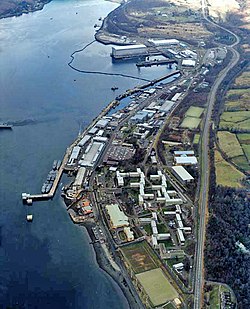HMNB Clyde: Difference between revisions
No edit summary |
|||
| Line 33: | Line 33: | ||
===Anti-nuclear demonstrations=== |
===Anti-nuclear demonstrations=== |
||
[[Image:Faslane1.jpg|thumb|250px|Anti-nuclear demonstration, Faslane, 2000]] |
|||
Given the presence of these nuclear capable missiles, Faslane has attracted demonstrations by [[Campaign for Nuclear Disarmament]] and other Scottish [[pressure groups]], including [[Trident Ploughshares]]. A permanent [[peace camp]] is outside the base gates, and there are frequent demonstrations at the base gates. The presence of Faslane is also an issue in [[Politics of Scotland|Scottish politics]]. The [[Scottish National Party]], the [[Scottish Socialist Party]] and the [[Scottish Green Party]] all oppose the deployment of nuclear weapons, although the [[Scottish National Party]] have made assurances that they would retain the base for the servicing of conventionally-armed and -powered naval units. It is not unusual for members of these parties, and indeed some from the [[Labour Party (UK)|Labour Party]], to attend rallies outside Faslane. Such events aim to keep the base closed for as long as possible by preventing its staff from arriving for work, and usually involve large numbers of protestors being arrested for non-violent [[civil disobedience]]. |
Given the presence of these nuclear capable missiles, Faslane has attracted demonstrations by [[Campaign for Nuclear Disarmament]] and other Scottish [[pressure groups]], including [[Trident Ploughshares]]. A permanent [[peace camp]] is outside the base gates, and there are frequent demonstrations at the base gates. The presence of Faslane is also an issue in [[Politics of Scotland|Scottish politics]]. The [[Scottish National Party]], the [[Scottish Socialist Party]] and the [[Scottish Green Party]] all oppose the deployment of nuclear weapons, although the [[Scottish National Party]] have made assurances that they would retain the base for the servicing of conventionally-armed and -powered naval units. It is not unusual for members of these parties, and indeed some from the [[Labour Party (UK)|Labour Party]], to attend rallies outside Faslane. Such events aim to keep the base closed for as long as possible by preventing its staff from arriving for work, and usually involve large numbers of protestors being arrested for non-violent [[civil disobedience]]. |
||
Revision as of 08:34, 1 November 2005

Her Majesty's Naval Base Clyde is a base of the Royal Navy in Scotland, best known as the home of the United Kingdom's nuclear weapons submarines. The base is actually two separate locations:
Faslane Naval Base
Faslane Naval Base, officially HMS Neptune, is situated on Gare Loch, which connects to the River Clyde in Scotland. The base serves as home base to the United Kingdom's fleet of Trident nuclear armed submarines, as well as conventional nuclear submarines.
Faslane was first constructed and used as a base in World War II. During the 1960s, the United Kingdom began negotiations with the United States of America regarding the purchase of a Polaris nuclear missile system to be fired from 5 specially constructed submarines. In the end, only four were constructed; Resolution, Repulse, Renown and Revenge. These four submarines were permanently based at Faslane. One boat was always on patrol at any given time. In times of political instability, sometimes two boats would be deployed at sea.
Vanguard class SSBNs
In the 1980s, the British Government announced plans to replace the Polaris submarines with the newly developed Trident missile system, also to be based at Faslane. These submarines were named:
Swiftsure class SSNs
Faslane is also home to the Swiftsure class of hunter-killer submarines (SSNs). The Swiftsure class is the older of the two SSN classes of the Royal Navy and is due to be replaced by the Astute class submarines.
Other vessels
The Royal Navy has announced that the Astute-class SSN will also be based at Faslane. Also based there are the Northern Ireland Squadron patrol vessels and mine countermeasures vessels of the 3rd MCMV Squadron.
The base is the headquarters of Flag Officer Scotland, Northern England and Northern Ireland (FOSNNI) and Commodore HMS Neptune. It is base to 3,000 service personnel, 800 of their families and 4,000 civilian workers.
Anti-nuclear demonstrations
Given the presence of these nuclear capable missiles, Faslane has attracted demonstrations by Campaign for Nuclear Disarmament and other Scottish pressure groups, including Trident Ploughshares. A permanent peace camp is outside the base gates, and there are frequent demonstrations at the base gates. The presence of Faslane is also an issue in Scottish politics. The Scottish National Party, the Scottish Socialist Party and the Scottish Green Party all oppose the deployment of nuclear weapons, although the Scottish National Party have made assurances that they would retain the base for the servicing of conventionally-armed and -powered naval units. It is not unusual for members of these parties, and indeed some from the Labour Party, to attend rallies outside Faslane. Such events aim to keep the base closed for as long as possible by preventing its staff from arriving for work, and usually involve large numbers of protestors being arrested for non-violent civil disobedience.
RNAD Coulport
The Royal Naval Armament Depot (RNAD) at Coulport, Loch Long is the other major part of HMNB Clyde. RNAD Coulport stores conventional armaments for Royal Navy vessels but is best known for its role in the Trident missile system.
Nuclear weapon storage bunkers have been excavated from a ridge. From here British-designed and built nuclear warheads can be fitted to the Trident missiles (built by Lockheed Martin). As the U.K. does not own any missiles, but rather has rights to 58 missiles from a "pool" shared with the U.S. Navy, this is a necessary capability. Whole missiles can be lifted out of or into a submarine, however the missiles are serviced at the U.S. Navy facility at Kings Bay.
